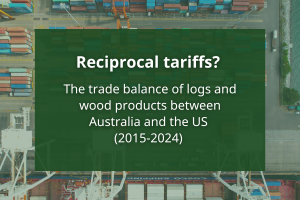Although the nation is slowly waking up to the situation, Australia has long been on the cusp of a productivity-sapping shortage of timber pallets. Stressed supply chains have been hoarding pallets, some of the ‘pool’ or ‘system’ companies – think of Chep and Loscam – appear to have under-estimated demand and pallet hoarding and all-the-while, timber supply is worse for pallets and other packaging than for any other purpose, right now.
Australia’s imports of wooden pallets were valued at AUD4.34 million year-ended September, 22.3% higher than a year earlier. In September, the value of imports was the second highest ever recorded – AUDFob0.7 million – continuing a run of very strong growth.
Growth in the value of imported wooden pallets is unsurprising. We anticipate there are four main drivers. First, the shortage of sawn softwood timber has all end-uses under pressure, second, the continued decline of access to native forests to provide hardwood timber required for pallets has reached its end game in some states and third, the impact of the floods across Australia has reduced timber supply significantly, over recent months.
The fourth reason appears pandemic disruption related. After being short of shipping containers and pallets at different points in the pandemic, supply-chain managers have shifted their approach from ‘just-in-time’ to ‘just-in-case’. Hoarding of pallets is now a factor in the supply chain. It does not appear to have been predicted.
It is important to note total supply of timber for packaging includes local production (our next briefing will address that supply) and imports of finished pallets.
In the first chart, we can see the monthly value of imported wooden pallets climbing across the pandemic, peaking in September 2022.
Monthly Australian Timber Pallet Imports: Jan ’20 – Sep ’22 (AUD)

Source: ABS & IndustryEdge
IndustryEdge considers it particularly relevant that the recent surge in imports commenced in early 2022, as floods wrought havoc across the Australian eastern seaboard. It points to just how tight supply has been – and will be in future.
Arising from continued demand for sawn structural timber products and the ‘short’ in supply of all materials across the pandemic, there has simply been no timber available to meet pressing demand.
The impact of successive closures of access to native forests across Australia also cannot be ignored when considering rising imports of pallets or other wooden packaging materials like creates and cases.
Returning to pallets specifically, the data shows the value of imports to Queensland lifted almost 86% over the year-ended September, to take the import lead against more populous NSW and Victoria. That is likely to be a consequence of the floods.
Annual Australian Timber Pallet Imports by State: Jan ’20 – Sep ’22 (AUDFob)

Source: ABS & IndustryEdge
|
YE September AUDFob |
2020 |
2021 |
2022 |
% Change Sep ’21 – Sep ’22 |
|
NSW |
1,159,514 |
1,319,263 |
1,144,616 |
-13.2% |
|
QLD |
649,603 |
860,194 |
1,595,969 |
85.5% |
|
SA |
19,593 |
21,669 |
1,680 |
-92.2% |
|
TAS |
23,022 |
1,388 |
129,741 |
– |
|
VIC |
1,057,175 |
1,292,525 |
1,455,668 |
12.6% |
|
WA |
40,326 |
52,324 |
12,179 |
-76.7% |
|
Total |
2,949,233 |
3,547,363 |
4,339,853 |
22.3% |
New Zealand is the main supplier of wooden pallets to Australia. Year-ended September 2022, the trans-Tasman trade was 22.0% lower than for the prior year, while Re-exports halved for the second successive year. Our team is undertaking further analysis and industry liaison to understand the specific nature of the Re-imports, but as a general rule, they mean items exported from a country and returned to it, without being further used where they were delivered.
The big growth in pallet imports came from diverse sources – China, Germany and a stack of ‘other’ increase dramatically as countries of origin over the most recent year.
Monthly Australian Timber Pallet Imports by Country: Jan ’20 – Sep ’22 (AUDFob)

Source: ABS & IndustryEdge
|
YE September AUDFob |
2020 |
2021 |
2022 |
% Change Sep ’21 – Sep ’22 |
|
Australia (Re-imports) |
694,417 |
343,533 |
171,621 |
-50.0% |
|
China (Mainland) |
33,792 |
49,396 |
655,909 |
– |
|
Germany |
49,001 |
1,034 |
660,819 |
– |
|
Latvia |
253,851 |
364,445 |
227,134 |
-37.7% |
|
New Zealand |
1,514,690 |
2,514,122 |
1,960,647 |
-22.0% |
|
Sweden |
72,904 |
59,169 |
11,877 |
-79.9% |
|
Other |
330,578 |
215,666 |
651,847 |
202.2% |
|
Total |
2,949,233 |
3,547,363 |
4,339,853 |
22.3% |



